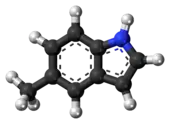 | |
 | |
| Names | |
|---|---|
| IUPAC name
5-Methyl-1H-indole | |
| Identifiers | |
3D model (JSmol) |
|
| ChEMBL | |
| ChemSpider | |
| ECHA InfoCard | 100.009.456 |
PubChem CID |
|
| UNII | |
CompTox Dashboard (EPA) |
|
| |
| |
| Properties | |
| C9H9N | |
| Molar mass | 131.178 g·mol−1 |
| Melting point | 58 to 61 °C (136 to 142 °F; 331 to 334 K) |
| Related compounds | |
Related compounds |
Indole 1-Methylindole 2-Methylindole (methylketol) Skatole (3-methylindole) 4-Methylindole 6-Methylindole 7-Methylindole |
Except where otherwise noted, data are given for materials in their standard state (at 25 °C [77 °F], 100 kPa).
Infobox references | |
5-Methylindole is an irritating organic compound with chemical formula C9H9N. 5-Methylindole is used as an intermediate in the synthesis of compounds with a variety of pharmacological properties, such as staurosporine-like bisindole inhibitors of protein kinases.[2]
References
- ↑ 5-Methylindole ChemExper Chemical Directory. Accessed 1 September 2005.
- ↑ Hanns Martin Kaiser; Wei Fun Lo; Abdol Majid Riahi; Anke Spannenberg; Matthias Beller & Man Kin Tse (2006). "New Synthetic Protocols for the Preparation of Unsymmetrical Bisindoles". Org. Lett. 8 (25): 5761–5764. doi:10.1021/ol062338p. PMID 17134266.
This article is issued from Wikipedia. The text is licensed under Creative Commons - Attribution - Sharealike. Additional terms may apply for the media files.